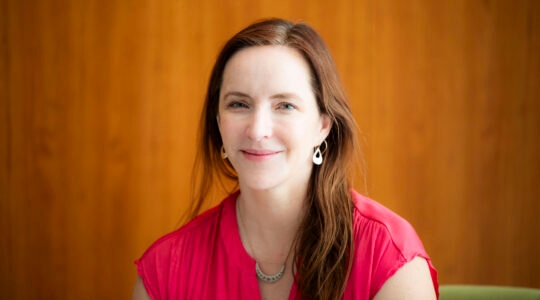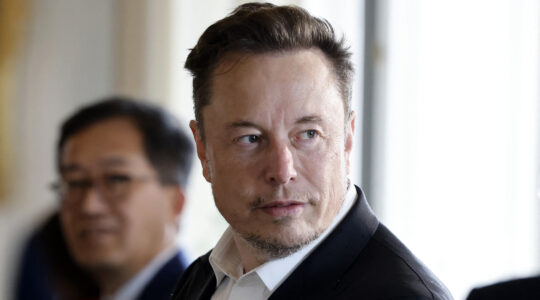
Exterior, top, and interior shots of the Canadian Museum of Human Rights in Winnipeg opening this weekend. (Flickr)
TORONTO (JTA) — On the fourth floor of the new Canadian Museum for Human Rights, visitors will find a gallery called “Examining the Holocaust,” which is devoted entirely to the story and lessons of the Shoah. On the same floor, in a smaller, adjacent space, a gallery called “Breaking the Silence” examines a cluster of five genocides officially recognized by the Canadian government: the Srebrenica massacre in Bosnia; the Armenian and Rwandan genocides; the Holodomor, or the starvation of millions of Ukrainians in the early 1930s; and, once again, the Holocaust.
“Examining the Holocaust” is just one of 11 galleries at the $351 million human rights museum that opens in Winnipeg, Manitoba, on Saturday. It is also the museum’s thorniest.
The permanent gallery has long been a source of controversy for the institution, which has fought accusations from a handful of Canada’s ethnic communities, ranging from Ukrainians to Armenians, that allowing the Holocaust its own space downplays the significance of the other human rights atrocities confined to a single room.
In interviews with JTA, museum officials defended their decision by asserting that the Holocaust is in fact exceptional, both as an act of 20th-century genocide and a pedagogic tool. As the trigger for international human rights legislation in the aftermath of World War II, the Holocaust is deserving of its own gallery, the officials said.
“It’s one of the most studied, most well-documented atrocities,” said June Creelman, the museum’s director of learning and programming. “One of the ways to educate is to start with something familiar and move to something unknown.”
The Canadian Museum for Human Rights grew out of several unsuccessful attempts by Jewish community leaders as far back as the late 1990s to attract government support for a national Holocaust museum, or a Holocaust gallery at the Canadian War Museum, in Ottawa. The efforts failed when the federal government, after staging parliamentary hearings, shied away from committing money to a project that memorialized only a single group’s history. (In August, Canada will unveil its first national Holocaust monument, an $8.5 million project steps from the Parliament in downtown Ottawa. The monument, designed by a team that includes renowned architect Daniel Libeskind, features six concrete triangles that together create points of a Star of David.)
It wasn’t until 2003 that the late Izzy Asper, a Manitoba-born media mogul and Jewish philanthropist, convinced Prime Minister Jean Chretien to sign on to a public-private partnership establishing a national human rights museum similar in scope to the Simon Wiesenthal Center’s Museum of Tolerance in Los Angeles. Asper, whose family foundation chipped in $22 million, always had his eye on a stand-alone Holocaust gallery — indeed, early museum blueprints indicated a Holocaust section would occupy more than 20 percent of the available gallery space. In the final design, it takes up less than 10 percent of the space.
Other galleries examine contemporary cases of human rights abuse, the history of civil rights in Canada — including the “head tax” that Chinese immigrants were charged in the late 19th century — and the work of Raphael Lemkin, the Polish-Jewish lawyer whose work on defining the term “genocide” led to the United Nations Convention on the Prevention and Punishment of the Crime of Genocide in 1948.
From the outset, museum fundraisers and programmers were adamant that the Holocaust serve as the intellectual and emotional starting point for the museum’s approach to human rights education. In 2008, a government advisory review wrote that the Holocaust “provides our paradigm for understanding the causes and processes of all mass, state-sponsored violence, as well as provides the inspiration for human rights protection on a world-wide scale.”
That sort of language, at a museum striving to tell multiple histories, has led to what Dirk Moses, a historian at the European University Institute in Florence, Italy, has called a “traumatic memory competition between those who postulated the Holocaust’s uniqueness and those who rejected it.” Moses has written extensively on the new Canada museum.
For his part, Shimon Fogel, CEO of the Centre for Israel and Jewish Affairs, a Canadian advocacy group, praised the museum for recognizing “that the pedagogic power of the Holocaust experience is of a fundamentally different scope and nature.”
But critics argue that the amount of attention focused on the Holocaust at the museum is woefully disproportionate, and they take strong exception to what is perceived as unfair precedence granted the Holocaust over other genocides.
The museum’s Holocaust exhibit occupies 4,500 square feet of space — 1,400 square feet more than the “Breaking the Silence” gallery. Maureen Fitzhenry, a museum spokeswoman, described the Holocaust gallery as having five sections, including the story of the Nazis’ rise to power and how the genocide was implemented, an exploration of how everyday people were complicit in the genocide and a 10-minute documentary about Canada’s unwillingness to absorb Jewish refugees fleeing Europe during World War II.
Content for the exhibits — all designed by Ralph Applebaum Associates, the firm behind the U.S. Holocaust Memorial Museum’s permanent exhibit — were developed with the input of independent scholars and public consultations involving thousands of Canadians.
The executive director of the Zoryan Institute, a Toronto-based think tank that researches Armenian diaspora issues, told the National Post last year he worried the Holocaust gallery would be so overwhelming that visitors would not “really absorb anything from the other galleries.”
Ukrainian-Canadian institutions have been especially rancorous, claiming the Holodomor, the Soviet-inflicted famine in 1932-33, is given insufficient consideration at the museum. In one provocative 2011 anti-museum campaign, the Ukrainian Canadian Civil Liberties Association, or UCCLA, mailed postcards to Canadians featuring an illustration of a pig whispering to a sheep, “All galleries are equal but some galleries are more equal than others.”
There are an estimated 1.2 million Ukrainian-Canadians, and many have close ties to the Prairie provinces, including Manitoba, which absorbed waves of Ukrainian immigrants starting in the 1890s. Lubomyr Luciuk, a professor of political geography at the Royal Military College and a member of the UCCLA, called the museum “divisive,” but expressed confidence that its contents would be revised in the future.
“UCCLA’s position is that no genocide, however tragic, should be given pride of place in a publicly funded national Canadian museum, meaning no nation’s tragedy, however well-documented or evocative, should receive preferential treatment with the Canadian Museum for Human Rights,” Luciuk, a longtime critic of the museum, told JTA.
Some scholars have cast doubt on the museum’s claim, as a justification for the stand-alone gallery, that the Holocaust had a larger impact on human rights legislation than did other acts of genocide.
Adam Muller, a University of Manitoba genocide scholar, pointed to a trend in contemporary scholarship — notably the work of Columbia University historian Samuel Moyn — disputing the impact that Holocaust consciousness had on the international human rights treaties signed after World War II, especially the 1948 United Nations Universal Declaration of Human Rights, and early understandings of the term “genocide.”
Muller, co-editor of a forthcoming book about human rights museums titled “The Idea of a Human Rights Museum,” is supportive of a special Holocaust gallery because of the wealth of scholarship available on the subject. But, he added, if it isn’t clear that the Holocaust precipitated the post-World War II human rights movement, “looking at the connection in the museum has kind of dubious value.”
JTA has documented Jewish history in real-time for over a century. Keep our journalism strong by joining us in supporting independent, award-winning reporting.





